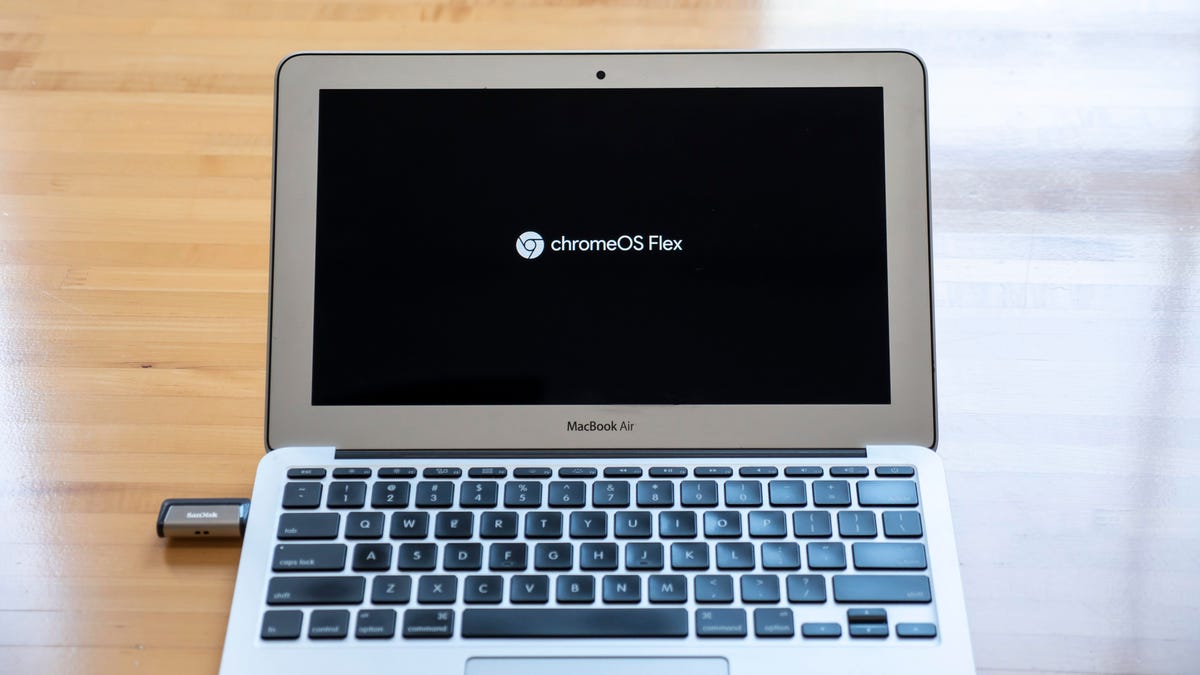 Why You Can Trust CNET
Why You Can Trust CNET How to Turn an Old Laptop Into a Chromebook With ChromeOS Flex for Free
Don't send your PC or Mac to the landfill just yet.

A thumb drive and an old laptop are all you need to get started with ChromeOS Flex.
Google's ChromeOS isn't available to install on a laptop or desktop like Windows or Linux, but the next best thing is Google's ChromeOS Flex. Formerly called Neverware CloudReady, the OS is mainly built for businesses and education, but Flex is free for personal use, and it's so lightweight that it's great for breathing new life into a computer that's struggling from the demands of Windows, MacOS or Linux.
Google acquired Neverware in December 2020 and the result of that is ChromeOS Flex. While CloudReady was good, Flex is much closer to the experience you'd get with a Chromebook or other ChromeOS device. That includes things such as the official Chrome browser, support for Family Link accounts including school-issued accounts and Phone Hub, which lets you connect to an Android phone to show notifications and share files between the phone and laptop. The one thing you don't get is access to the Google Play store and Android apps.
ChromeOS Flex runs well even on old hardware. That's why it's such a good option for repurposing a laptop that can no longer run current versions of Windows, MacOS or Linux. Google only guarantees Flex to work on a growing list of certified models, however. If your model isn't certified, that doesn't mean it won't work, though, just that full functionality and performance aren't a given.
You can wipe a laptop's drive and install ChromeOS Flex or run the OS off a thumb drive to test it out first.
You choose: Trial run or full install
One of the best features of ChromeOS Flex, though, is that you can run it off a USB flash drive or SD card to test it out first without completely overwriting your current OS. For the best performance, it's not recommended to run Flex from a flash drive full time, but it will let you see if it'll work for your needs.
Installing ChromeOS Flex is quick and painless. The first step is to gather everything you need:
- A USB thumb drive or SD card 8GB or larger
- A Windows, Mac or Linux computer to install ChromeOS Flex on
Note that installing ChromeOS Flex will completely erase your entire hard drive. Any important files should be backed up first. You'll also need a ChromeOS, Windows PC or Mac device with the current version of the Chrome browser installed. This will be used to create the ChromeOS Flex USB installer and it doesn't need to be the same device you plan to install it on. The thumb drive will also be completely erased when creating the installer.
To run ChromeOS Flex, the target laptop (or desktop) will need to be Intel or AMD x86-64-bit compatible (newer than 2010 for the best experience), have 4GB RAM or more, have at least 16GB of storage and you'll need full administrator access to the BIOS. Once you've got everything needed, it's time to create the USB installer.
- Open a Chrome browser window on a ChromeOS, Windows PC or Mac device and add the Chromebook Recovery Utility extension via the Chrome web store. This is what you'll use to build the USB/SD card installer.
- Go to the Chrome browser's extensions menu located at the top right of the Chrome browser window (it looks like a tiny puzzle piece). Click on it and a drop-down list of extensions will appear. Find the Chromebook Recovery Utility on the list and click on it to launch. The utility might need to be toggled on, too, which can be done by clicking on Manage Extensions at the bottom of the drop-down list of extensions.
In the Recovery Utility, instead of selecting a model to recover, you'll select ChromeOS Flex.
- When the Chromebook Recovery Utility launches, you'll be asked to identify what model Chromebook you'll be recovering. However, there will be a link labeled Select a model from a list in the dialog box. Click that link and from the Select a manufacturer drop-down list that appears select Google Chrome OS Flex. Below that drop-down is another labeled Select a product from which you'll choose Chrome OS Flex.
- Next, insert your flash drive or SD card into the device you're using to create the installer, select it as your target drive and then click Create now. The creation process takes up to 20 minutes but mine was done in half that time. Once the installer is finished, the drive can be ejected and is ready to use.
When the installer is done, your USB drive or SD card are ready to use to run or install ChromeOS Flex.
You're almost done. It's time to grab the laptop you want to convert to a Chromebook. Make sure the laptop is turned off and insert your ChromeOS Flex installer thumb drive or SD card.
The next step is to boot the laptop from the thumb drive instead of the internal storage drive. This requires you to press a boot key as the laptop is booting up. Boot keys vary by manufacturer. For instance, I converted a MacBook Air and its boot key is the Option key. Google has a list of boot keys for major manufacturers if you're not sure what yours is.
Turn on the laptop and, as it boots, press the boot key to interrupt the boot process. You may need to press and hold the key or hit it repeatedly to enter the boot menu. If done correctly, the laptop should give you the option to select which drive you'd like to boot from, the laptop's internal drive or your USB drive. Select the USB drive and press Enter.
Once you enter the boot menu options, select the USB installer drive you created to get started.
If you've done everything correctly, you'll see the ChromeOS Flex splash screen followed by a Welcome to ChromeOS Flex screen. (If not, retrace your steps using Google's installation guide.) From there you can choose to test the OS and run it directly from the flash drive or install ChromeOS Flex on the internal storage. Doing the latter gives you the best performance; however, it also erases all content from the internal drive and the native OS can't be recovered. If you aren't 100% certain you want to use ChromeOS Flex, try running it from the USB drive first.
The full OS installation can take up to 20 minutes (my MacBook Air was done in less than 5 minutes, though). Regardless of how you decide to run it, though, the setup process is the same: Select a Wi-Fi network, agree to Google's terms of service, choose if the Chromebook is for yourself or a child, and then sign in using your Google account information.
Sign in to ChromeOS Flex with a Google account and password and you're ready to get to work.
Ta-da, Chromebook! At least, close enough for most needs. Performance is going to depend on what your laptop has in it. My install was on an early 2015 MacBook Air and it's much faster than it was with MacOS on it. The only downside for my particular model is the built-in webcam is not supported but an external USB webcam worked just fine.
If you've got a USB flash drive and an old laptop, it's certainly worth the minimal effort to test out and, again, it's free.
Best laptops for 2023
A selection of the best laptops you can buy right now
- Most universally useful: MacBook Air M2
- Best budget laptop: Acer Swift 3
- Best Chromebook: Acer Chromebook Spin 713
- Best budget gaming laptop: HP Victus 16
Computing Guides
Laptops
Desktops & Monitors
Computer Accessories
Photography
Tablets & E-Readers
3D Printers

